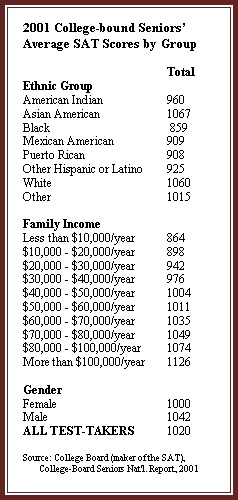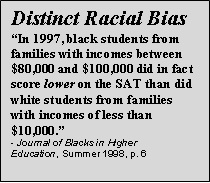 The myth of ‘meritocracy’
The myth of ‘meritocracy’
Affirmative Action is the Desegregation Program for Higher Education – Not a ‘Preference’
Standardized test scores are not a race-neutral admissions criteria. Without, affirmative action, they give a preference to white students.
In their arguments, the opponents of affirmative action constantly refer to a grid that shows SAT scores across the top and GPA down the side. They point out the fact that there are very few URM (under-represented minority) students in the the upper left hand corner of the grid (highest GPA combined with highest test scores), and that the few that are, generally have a high chance of being offered admission. They claim this demonstrates that URM students are being given a “preference.”
Quack “science”
In order to conclude that the grid shows a “preference”, one must accept the false presumption that these criteria – GPA and SAT/ACT – are racially neutral and reflect academic ability and performance equally across all races. The presumption is patently UNTRUE. Standardized tests reflect the racial inequalities and biases in our society.
Built-In Bias
Part of the racial bias of the SAT is built into the statistical methods used to create the test each year.
As explained by Emory University Professor and Psychometrician Martin Shapiro in the trial testimony of Grutter v. Bollinger (http://ueaa.net/transcript/08-020601-shapiro-rosner-escobar.txt) ETS (Education Testing Service) places unscored sample questions on their tests each year and then does a statistical analysis to determine what demographic answered those questions correctly to decide whether or not to include those questions in future tests. If the demographic which has historically done well on the test overall in the past correctly answers the sample question, it is used in future tests. If the demographic (lower income and URM students) that historically has NOT done well on the test answers those sample questions correctly, the question is NOT used on future tests.
SAT/ACT/LSAT/MCAT/GRE = ‘white preference tests’
ETS does not dispute the basic facts. It is not necessarily done out of racist intent, but for “statistical consistency” – so that each test, each year, measures more or less the same thing and thus a certain score means the same thing over the years. On the other hand, ETS has known of the disparate impact of its methodology, and has chosen to do nothing. It is why the use of standardized tests in admissions should be eliminated. Standardized tests are the sentinel at the door of higher education keeping black, Latino/a, Native American, and Asian students from many countries (Filipinos, Pacific Islanders, Hmong, etc.) out.
Study Proves that Black and White Students With Identical Academic Performance Have Huge Test Score Discrepancy
Another way of demonstrating the bias of standardized tests was shown in a 1998 study performed for the co-defendants in Grutter. David White and Bill Kidder (http://ueaa.net/transcript/11-020901-garcia-white.txt) refined a previous study of 19,000 college students that graduated from elite colleges who then took the LSAT. They paired white and black, and white and Latino students who graduated from the same elite college, in the same major, and had the same GPA within a 10th of a point – i.e. they paired white and URM students who had demonstrated identical academic achievement, and then compared their standardized test scores.
They found a huge racial gap in test scores – between black and white students, black students scored 9.2 points lower than their white peers with the same GPA, a score gap that represents the difference between being admitted or rejected – not just a difference of which tier of law school they might gain admittance to. The difference between white and Latino students was 7.0 – also significant. Clearly, test scores don’t represent academic ability.
SAT Does Not Predict Academic Success
The University of Texas system’s abandonment of the SAT requirement for the top 10 percent of every high school (according to
 GPA) has led to an increase in academic success. In 1997, the UT system began admitting the top 10 percent of each Texas high school, regardless of their SAT scores. Since then,the average SAT of these top 10 percent students has gone down from 1242 to 1212, but their average first-year GPA has risen. Also, these top 10 percent students, in terms of academic performance in college, have outperformed non-top 10 percent students with SAT scores that are 200 to 300 points higher. (University of Texas-Austin Admissions Research: http://www.utexas.edu/student/research/reports/admissions/ResearchHome.htm)
GPA) has led to an increase in academic success. In 1997, the UT system began admitting the top 10 percent of each Texas high school, regardless of their SAT scores. Since then,the average SAT of these top 10 percent students has gone down from 1242 to 1212, but their average first-year GPA has risen. Also, these top 10 percent students, in terms of academic performance in college, have outperformed non-top 10 percent students with SAT scores that are 200 to 300 points higher. (University of Texas-Austin Admissions Research: http://www.utexas.edu/student/research/reports/admissions/ResearchHome.htm)
The Effects of Test Prep
Statistical analysis also shows that URM students score slightly higher than white students on the most difficult questions, and worse on what are considered the easiest questions. The explanation generally offered to explain this trend is that minority students tend to second-guess themselves much more than white students. They think they are being “tricked” when they see questions that seem too obvious –as a result of their life experience with racism. There are other facts that highlight the fact that standardized tests are not racially neutral . One of them is the effect of test prep or the lack thereof. White students, for reasons of cost and information, have far greater access to test prep classes that substantially boost scores.
 Stereotype Threat
Stereotype Threat
When capable black college students fail to perform as well as their white counterparts, the explanation often has less to do with preparation or ability than with the threat of stereotypes about their capacity to succeed. Stanford Sociology Professor Claude Steele has dubbed this dynamic “stereotype threat” (see: http://www.theatlantic.com/magazine/archive/1999/08/thin-ice-stereotype-threat-and-black-college-students/4663/). Professor Steele carried out studies that have been successfully reproduced by other researchers that show that the threat of negative stereotypes about one’s race causes test anxiety that has a significantly negative affect on test performance. In plain language, when black or Latino students sit down to take a high-stakes test, they carry the burden of feeling they must disprove all the negative stereotypes about their race, a burden which white students do not shoulder.
As a result of this same dynamic, studies show that the highest performing minority students – i.e. those that care the most about their performance – exhibit the greatest disparity between their general academic performance and their test scores.
The Real Preferences: Invisible to Those That Most Enjoy Them
These arguments undermine the assumptions of the opponents of affirmative action, and those that so wrongly apply the term “preferences” to minority students when, if you look at real society in the most concrete, rather than abstract terms – who gets the best educational opportunities, who get the best healthcare (even among those who are insured), who gets the longest prison sentence for the same offense, etc. it is obvious that white people are the ones who receive “preferences”. It’s just that the preferences are so much a part of dominant culture, and so universal, they are invisible to those who enjoy them.
To help BAMN fight to overturn the ban on affirmative action in California and Michigan, please fill out the interest form below.
Stay updated on BAMN’s work on Affirmative Action:
